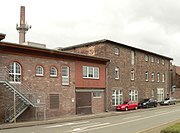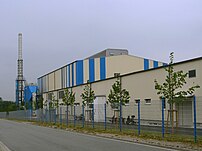Noelle + from Campe Glashütte
| Noelle + from Campe GmbH & Co. KG | |
|---|---|
| legal form | GmbH & Co. KG |
| founding | 1866 |
| Seat | Boffzen |
| management | Thomas Köhler, Peter Pokorny |
| Number of employees | 500 (2020) |
| sales | around € 90 million (2020) |
| Branch | Glass manufacturing |
| Website | nuvc.de |
| Status: 2020 | |
Noelle + von Campe Glashütte is a manufacturer of glass packaging based in Boffzen in Lower Saxony . The medium-sized company supplies the food industry and has a 15% share of glass packaging in the German market. The company, which was founded in 1866 as a glassworks , has 500 employees in two local factories. In 2012 the annual turnover was 78 and in 2014 around 85 million euros and in 2020 90 million euros.
Products
The product range includes around 400 shapes of glass vessels in sizes from 50 ml to 5 liters. The packaging classics since 1972 have been honeycomb-shaped hexagonal jars for Langnese honey . In the founding period after 1866, the glass factory produced all kinds of hollow glass , including drinking vessels and mason jars . The product range in the 19th century also amounted to up to 400 items; including aquariums , ship lanterns and lampshades. Successful products of the early days were siphons , rejects containers and baby bottles . The siphon bottles manufactured from 1870 onwards were exported as high-quality glass vessels, including to the USA .
history
founding
The company was founded as a glassworks in 1866 by the owner of the porcelain factory Fürstenberg Heinrich Witte, the Boffzen master carpenter Heinrich Schmidt and the Fürstenberg building contractor Friedrich Bartling. The company, with a share capital of 45,000 Taler , traded under the name Bartling & Co. It was founded in anticipation of a rail connection from Boffzen, which happened in 1876 with the opening of the Holzminden – Scherfede connection . The glassworks went into operation in 1867 with a Botius furnace, which was soon replaced by the more economical Siemens-Martin furnace . In the first few years there were several changes in the company's shareholders. After the entry of the brothers Heinrich and August Noelle, who ran a metal goods factory in Lüdenscheid , and August von Campe, the glass factory has been operating under the current name Noelle + von Campe since 1874 .
20th century
At the beginning of the 20th century, the company fell into a crisis in 1917 when, towards the end of the First World War, the supply of coal for the glass furnaces stopped. Production continued as a merger with Georgshütte, which had existed in Boffzen since 1872 . After further crises in the 1920s, the Noelle + von Campe glass factory became insolvent in 1931, stopped production and laid off 120 employees. The cause was the bankruptcy of the Noelle brothers' partner company in Lüdenscheid. Otto von Campe, who had become the sole owner, found investors in 1934 and reopened the glass factory with 40 workers. The number of employees doubled to around 80 in the 1940s. During the Second World War , as in many other glassworks, glass parts were made for the glass mine 43 . During the war, the factory, like the Georgshütte, employed female forced laborers , who were housed in a barrack camp in the Rottmündal valley in the order of 30 to 60 people . In the post-war period , production started again in 1946. Mainly the mason jars necessary for self-sufficiency were produced in large numbers, at times up to 400,000 units per month.
21st century
In 2009, a new factory building, Plant II, was completed, creating 160 new jobs. Also in 2009 there was a major fire that caused damage of 8 million euros and led to the introduction of a plant fire brigade . This was used, for example, in September 2016 in the event of a fire on a conveyor belt for returning broken glass.
In 2014, the company invested, among other things, 11 million euros for the expansion of the production line and in 2017 a further 6.5 million euros for a new furnace in the main plant in Boffzen.
Today Noelle + von Campe is one of seven remaining glassworks in the Weser region. While the smelters in Grünenplan, Holzminden, Bad Münder, Rinteln, Obernkirchen and Nienburg are branches of international corporations such as Owens-Illinois , Ardagh and Schott , Noelle + von Campe has maintained its position as a sole proprietorship to this day and is that for glass production in the region last remaining family business.
The Boffzen Glass Museum has been providing information on the history of glass production in Boffzen since 1991 , where a special exhibition was on view from August 31 to October 30, 2016 to mark the company's 150th anniversary.
literature
- Gord von Campe: Noelle + von Campe Glashütte GmbH: Chronicle 1866–1981 . Boffzen 1986, OCLC 258393457 .
- Björn Lohnert: The glassworks. In: Boffzen community (ed.): Chronicle of the Boffzen community. [856-2006; 1150 years]. Beverungen 2006, OCLC 552036988 , p. 197 ff.
- Sven Tode : A world in glass - 150 years of Noelle + von Campe 1866–2016. Verlag Hanseatischer Merkur, Hamburg 2016, ISBN 978-3-922857-67-9 .
Web links
Individual evidence
- ↑ a b Facts and Figures. Noelle + from Campe GmbH & Co. KG, accessed on July 24, 2020 .
- ↑ a b Rene Wenzel: Eleven million euros for line 9 . In: Westfalen-Blatt . August 22, 2014 ( westfalen-blatt.de ).
- ↑ Samtgemeinde Boffzen.NS forced labor. at topography of memory in southern Lower Saxony
- ↑ David Schellenberg: Fire at glass producer Noelle & von Campe in Boffzen . In: New Westphalian . September 2, 2016 ( nw.de ).
- ↑ Michael Robrecht: New melting furnace is built in record time . In: Westfalen-Blatt . February 17, 2017 ( westfalen-blatt.de ).
- ↑ Michael Funk: Glas von der Weser - yesterday, today and tomorrow sketches for a regional branch history , p. 416, 418
- ↑ Simone Flörke: Museum documents the history of glass production in Boffzen . In: New Westphalian. August 14, 2016 ( nw.de ).
Coordinates: 51 ° 45 ′ 3.1 ″ N , 9 ° 23 ′ 54.3 ″ E




